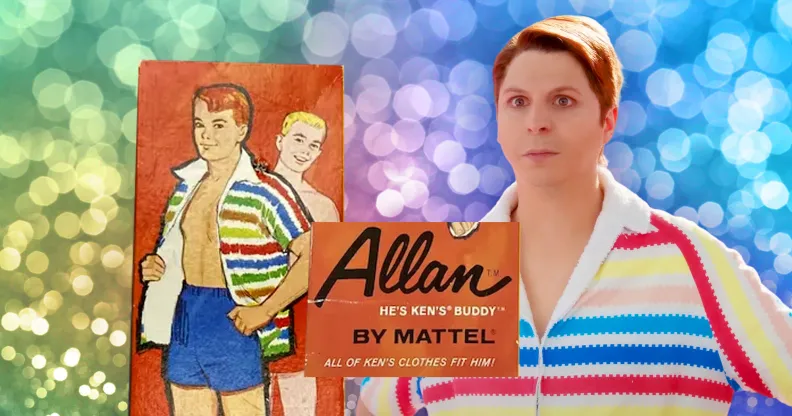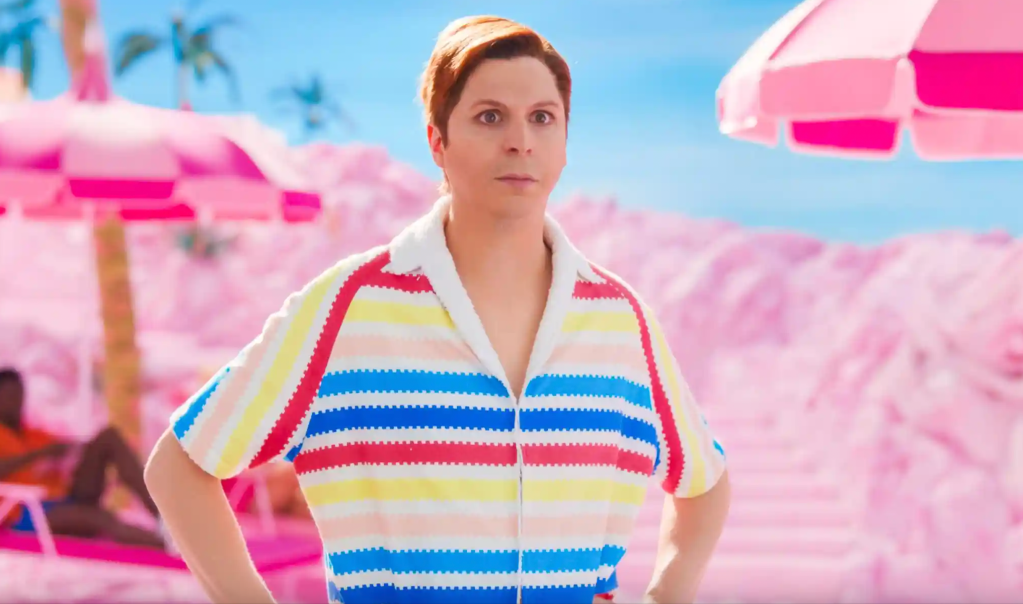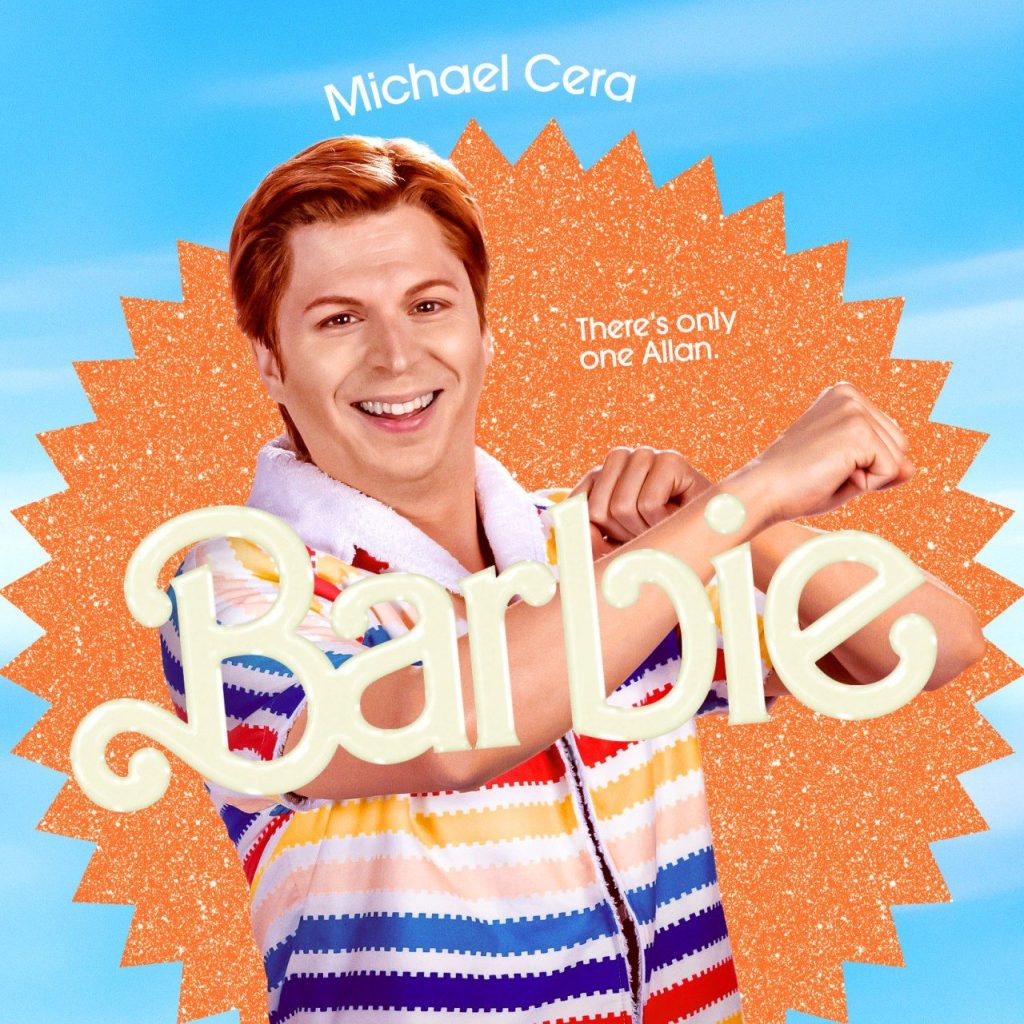Barbie: For queer people, Michael Cera’s Allan is the most important doll in the toy box

Barbie’s Allan reflects what so many young queer people feel. (Warner Bros. Pictures/Getty/hzgoodar.live)
Margot Robbie is Barbie’s ingenuous heroine. Ryan Gosling is Barbie’s vacuous antagonist. Yet Michael Cera, who plays the perpetually anxious and gay-coded Allan, is Barbie’s surprising heart and soul.
Despite casting several queer icons – including Alexandra Shipp as Writer Barbie, and the scene-stealing, FLAT FEET!-screeching trans icon Hari Nef as Doctor Barbie – queer representation in Barbie’s storyline is on the light side, to say the least.
It’s fair enough, though. While some Barbie fans had suspected that Margot Robbie’s Stereotypical Barbie would be a lesbian, thanks to everyone’s collective childhood memory of banging Barbie dolls together, Robbie herself made the excellent point that Barbies don’t really have a sexual orientation. After all, they’ve got plastic mounds, not genitals.
LGBTQ+ fans who feel a bit cheated, considering the film’s camp and colourful aesthetic, should fear not though: Michael Cera’s Allan brings all the queer undertones we need.

Allan was introduced to the Mattel dynasty way back in 1964, pitched as ‘Ken’s Buddy’, though consumers saw him for exactly what he was: an unnecessary marketing ploy.
Considering the Kens themselves are barely needed in Barbieland – in the film, they don’t even appear to have homes – was there ever a need for an Allan? He was swiftly binned two years after Mattel introduced him, before he was briefly revived and rebranded as ‘Alan’, with one ‘L’, in 1991 and 2002.
Allan might only be an unfortunate misstep in the Mattel empire, but in Greta Gerwig’s record-breaking Hollywood blockbuster, he gets a new lease of life, and cements himself as the queer community’s gateway into Gerwig’s pastel coloured dreamscape.
In any context, Gerwig has done a fabulous job at using Allan as one of the film’s very best comedic devices. In his opening scene, narrator Helen Mirren introduces him as “Just Allan”, the only male doll of which no replicas exist. “Yeah, I’m confused about that,” Cera responds.
In that brief 10 second introduction, we can already see Allan for what he is to the Barbie universe: an outlier. He doesn’t fit in with the world he inhabits, and this fact makes him slightly uncertain of himself. In those 10 seconds, he establishes himself as a character that so many queer people can see their younger selves reflected in.
For all of its feminist messaging and self-empowerment mantras, the fact remains that Barbieland largely reflects the binaries of the real world; the Barbies should be ruling the town with the other Barbies, the Kens should be being just Kens, with the other Kens.
Allan, though, is different. He’s not so content with being buff and doing beach with the Ken dolls. When Ryan Gosling’s Ken returns from the real world on a misogynistic power trip with a plan to instate the patriarchy into Barbieland, Allan is the first to call it out for what it is, and is intent on helping the Barbies and Gloria (America Ferrera) to take back control.
When the Barbies turn up to the constitutional vote to thwart Gosling’s plan to turn Barbieland into Kenland, Allan is right there alongside them, hanging out with the gals once again.
Yet, he’s no man hater, either – when Ken runs into the sea and gets sent flying back onto the sand, Allan lets out a concerned cry, keen to make sure his friend is OK. He’s a soft, sensitive soul.

Watching the film, I couldn’t help but see my young, gay self in Allan, even if just slightly. Making friends with the girls, as the boys just weren’t a crowd I felt comfortable around. Feeling out of place in a world that just didn’t seem to understand who I was.
Wearing my emotions on my sleeve, as I didn’t quite know how to bottle it up in the way other boys could – and often getting teased because of it. As I grew up, being able to see how toxic masculinity had warped the world view of so many boys and men I knew.
Putting the psychoanalysis aside though, and Allan remains as queer-coded as a genital-less doll can be, particularly thanks to a few cheeky nods from Gerwig.
Despite the Allan doll supposedly marrying Barbie’s friend Midge in the Mattel universe, the marriage isn’t alluded to at all in the film, despite Midge (Emerald Fennell) starring.
In 2020, a tweet featuring Allan’s original 1964 box went viral. The box features a shirtless Ken standing behind Allan, with the tagline: “All of Ken’s clothes fit him!”.
They hung out topless, and wore each other’s clothes? For the queers of today that meant that, you know, perhaps Ken and Allan were more than just buddies.
It’s a line that Gerwig consciously included in the film, perhaps as a wink-wink-nudge-nudge to Allan’s queer connotations. Plus, let’s not forget the part of the film in which all of the Barbies are tending to all of the Kens’ needs, with Allan himself also having to help out – by rubbing Ken’s feet.
Even Cera himself picked up on Allan’s historical queerness, recently telling ScreenRant that he read Gerwig’s script as Allan being “obsessed with Ken, if not in love with him”.
“I love that he just wants the best for Ken, even if that means Ken not being near him,” Cera explained. “He wants Ken’s happiness.”
In a Barbieland seemingly devoid of explicit queerness, Cera’s fish-out-of-water take on Allan is the closest thing we’ve got. He’s not perfect, but there’s only one Allan.
How did this story make you feel?

